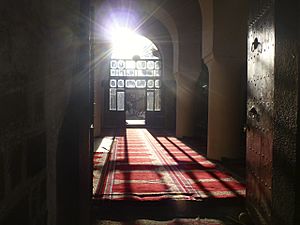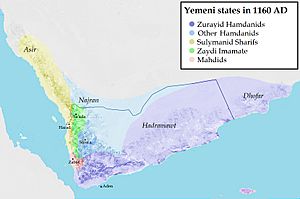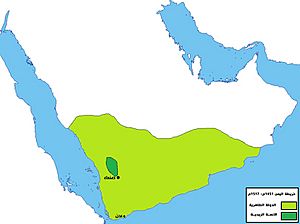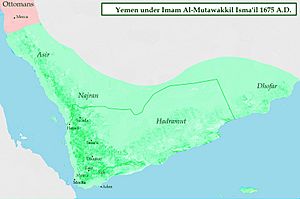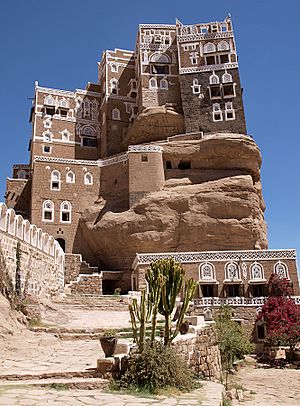History of Yemen facts for kids
The history of Yemen tells the story of one of the oldest places where people built civilizations in the Near East. Yemen had fertile land and enough rain, which helped a lot of people live there. The ancient Greek geographer Ptolemy even called it Eudaimon Arabia, meaning "Fortunate Arabia" or "Happy Arabia".
People in Yemen developed their own writing system, the South Arabian alphabet, between 1200 and 800 BC. This is why historians believe the ancient Yemeni kingdoms started around that time. From the 12th century BC to the 6th century AD, six powerful civilizations controlled the important spice trade: Ma'in, Qataban, Hadhramaut, Awsan, Saba, and Himyar. Then, Islam arrived in 630 AD, and Yemen became part of the larger Muslim world.
Contents
Ancient Kingdoms and Empires
Yemen has always been a meeting point for different cultures because of its long coastline and important trade routes on the west side of the Arabian Peninsula. Large towns existed in the mountains of northern Yemen as early as 5000 BC. We don't know much about how these early Bronze Age groups became the trade-focused kingdoms.
The Sabaean Kingdom began around the 11th century BC. There were four main kingdoms in South Arabia: Saba, Hadramout, Qataban, and Ma'in. Saba is thought to be the biblical Sheba and was the most powerful. Sabaean rulers used the title Mukarrib, which probably meant "unifier" or "priest-king." Their job was to bring different tribes together. The Sabaeans built the amazing Great Dam of Marib around 940 BC to control seasonal floods.
Between 700 and 680 BC, the Kingdom of Awsan controlled Aden and nearby areas. A Sabaean Mukarrib named Karib'il Watar I became a king and conquered Awsan. This expanded Sabaean rule across much of South Arabia. Because there wasn't enough water, the Sabaeans couldn't unite the whole Arabian Peninsula. Instead, they set up colonies to control trade routes. Sabaean influence spread to Eritrea and Ethiopia, bringing their alphabet, religion, and art. The Sabaeans felt connected through their religion, worshipping El-Maqah and believing they were his children. For centuries, they controlled trade through the Bab-el-Mandeb, a narrow sea passage.
By the 3rd century BC, Qataban, Hadramout, and Ma'in became independent from Saba. The Minaean kingdom reached as far as Dedan, with its capital at Baraqish. Saba regained control over Ma'in after Qataban fell around 50 BC. By the time the Romans came to Yemen in 25 BC, the Sabaeans were again the strongest power. The Roman general Aelius Gallus was sent to take control of the Sabaeans. The Romans didn't know much about Yemen. Their army of 10,000 men reached Marib but couldn't conquer it. It took them six months to get to Marib and two months to return to Egypt.
After the Roman visit, the country became chaotic. Two groups, Hamdan and Himyar, fought for power. The Himyarites allied with Aksum in Ethiopia against the Sabaeans. A powerful Sabaean king, El Sharih Yahdhib, defeated the Himyarites and Aksum. He was proud of his victories and added "Yahdhib" (suppressor) to his name. He built the Ghumdan Palace in Sana'a, which became an important city.
The Himyarites took Sana'a from Hamdan around 100 AD. But tribes rebelled and took Sana'a back around 180 AD. It wasn't until 275 AD that Shammar Yahri'sh united Yemen under Himyarite rule. The Himyarites stopped worshipping many gods and followed a single God, a belief called Rahmanism. In 354 AD, the Roman Emperor Constantius II sent a mission to convert the Himyarites to Christianity, but local Jews resisted. Inscriptions have been found in Hebrew and Sabaean praising the Himyarite rulers for supporting the Jewish people.
According to Islamic stories, King As'ad The Perfect supported the Jews of Yathrib. Inscriptions show he led military campaigns to central Arabia to help his allies. He died in 445 AD after ruling for almost 50 years. By 515 AD, Himyar was divided by religious differences, leading to a conflict that brought in the Aksumites. The last Himyarite king, Mu'di Karab Ya'fir, was Christian and supported by Aksum against his Jewish rivals.
After Mu'di Karab Ya'fir died around 521 AD, a Jewish leader named Yousef Asar Yathar came to power. His name "Yathar" means "to avenge." Christians in Yemen, with help from Aksum and Byzantium, had been persecuting Jews and burning synagogues. Yousef took revenge with great cruelty. He attacked the port city of Mocha, killing many and capturing others. He also sent an army to Najran, where they destroyed the Christian community. Christian sources describe Dhu Nuwas as a Jewish fanatic, while Islamic stories say he threw 20,000 Christians into burning pits. However, Dhu Nuwas's own inscriptions don't mention these fiery pits. The Byzantine Emperor Justin I asked Aksumite King Kaleb to attack Yousef. A combined army of Byzantine, Aksumite, and Arab Christians defeated Yousef around 525-527 AD, and a Christian king was put on the Himyarite throne.
Esimiphaios was a local Christian leader who burned an ancient Sabaean palace in Marib to build a church. Many tribes did not accept his rule. In 531 AD, a warrior named Abraha took over. He refused to leave Yemen and declared himself an independent king. Emperor Justinian I sent a delegation to Yemen, hoping the Christian Himyarites would help fight Persia. Justinian also gave the title of "king" to Arab leaders in central and north Arabia.
A prince named Yazid bin Kabshat rebelled against Abraha. A peace agreement was made after the Great Dam of Marib was damaged. Abraha died around 555-565 AD. The Sasanid empire (Persia) took over Aden around 570 AD. Under their rule, most of Yemen was independent, except for Aden and Sana'a. This time marked the end of ancient South Arabian civilization, as the country was divided among many independent groups until Islam arrived in 630 AD.
Yemen in the Middle Ages
The Arrival of Islam and Early Dynasties
Prophet Mohammed sent his cousin Ali to Sana'a and nearby areas around 630 AD. Yemen was a very advanced region in Arabia at that time. The Banu Hamdan group was one of the first to accept Islam. Mohammed also sent Muadh ibn Jabal to Al-Janad and wrote letters to tribal leaders. This was because Yemen was divided and didn't have a strong central government. Many Yemeni tribes, including Himyar, sent groups to Medina around 630-631 AD to accept Islam. Some Yemenis, like Ammar ibn Yasir and Abu Musa Ashaari, had already become Muslims.
A man named 'Abhala ibn Ka'ab Al-Ansi drove out the remaining Persians and claimed to be a prophet. He was killed by a Yemeni of Persian background named Fayruz al-Daylami. Christians in Najran and Jews agreed to pay a tax called Jizya, though some Jews, like Wahb ibn Munabbih, converted to Islam.
Yemen was stable during the Rashidun Caliphate. Yemeni tribes played a big role in the Islamic conquests of Egypt, Iraq, Persia, and other regions. Yemeni tribes who settled in Syria helped strengthen the Umayyad rule. However, the Umayyad Caliphate never fully controlled all of Yemen. In 745 AD, Imam Abdullah ibn Yahya Al-Kindi was chosen to lead the Ibāḍī movement in Hadramawt and Oman. He drove out the Umayyad governor from Sana'a and captured Mecca and Medina in 746 AD. Al-Kindi, known as Talib al-Haq (Seeker of truth), created the first Ibadi state but was killed around 749 AD.
Muhammad ibn Abdullah ibn Ziyad started the Ziyadid dynasty in Tihama around 818 AD. Their state stretched from Haly (in Saudi Arabia) to Aden. They officially recognized the Abbasid Caliphate but ruled independently from their capital in Zabid. This dynasty mostly controlled only the coastal area of Yemen. A Himyarite group called the Yufirids ruled the highlands from Saada to Taiz, while Hadramawt was an Ibadi stronghold. The Ziyadid dynasty in Zabid had a special connection with Abyssinia, trading slaves and other goods.
The first Zaidi imam, Yahya ibn al-Husayn, came to Yemen in 893 AD. He founded the Zaidi imamate in 897 AD. He was a religious scholar invited to Saada to settle tribal arguments. Imam Yahya convinced local tribes to follow his teachings. His ideas spread slowly across the highlands, and the tribes of Hashid and Bakil accepted his rule. Yahya tried to capture Sana'a from the Yufirids in 901 AD but failed. In 904 AD, new Isma'ili followers invaded Sana'a. Between 904 and 913 AD, Sana'a was conquered over 20 times by Isma'ilis and Yufirids. The Yufirid emir As'ad ibn Ibrahim took Sana'a back in 915 AD. The country was in chaos, with Sana'a becoming a battleground for different groups.
The Yufirid emir Abdullah ibn Qahtan attacked and burned Zabid in 989 AD, greatly weakening the Ziyadid dynasty. After 989 AD, the Ziyadid rulers lost real power. Slaves then held power in Zabid, eventually forming their own Najahid dynasty around 1022 or 1050 AD. They were recognized by the Abbasid Caliphate but only ruled Zabid and four nearby areas. The rise of the Ismaili Shia Sulayhid dynasty in the Yemeni highlands made their history less important.
The Sulayhid Dynasty
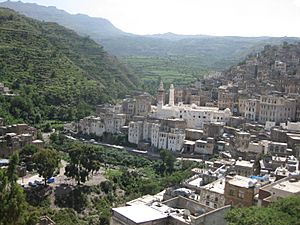
The Sulayhid dynasty started in the northern highlands around 1040 AD. At that time, different local groups ruled Yemen. In 1060 AD, Ali ibn Mohammed Al-Sulayhi conquered Zabid and killed its ruler. His sons fled. Hadramawt also came under Sulayhid control after they captured Aden in 1062 AD. By 1063 AD, Ali had conquered most of Yemen. He then marched to Hejaz and took Makkah. Ali was married to Asma bint Shihab, who ruled Yemen alongside him. Her name was even mentioned in the Friday prayers, a rare honor for an Arab woman.
Ali al-Sulayhi was killed by the sons of the former ruler of Zabid in 1084 AD. His son Ahmad al-Mukarram attacked Zabid and killed 8,000 people. He then appointed the Zurayids to govern Aden. Ahmad al-Mukarram, who was injured in war, retired in 1087 AD and gave power to his wife, Arwa al-Sulayhi. Queen Arwa moved the capital from Sana'a to Jibla, a small town in central Yemen. Jibla was close to the Sulayhid's wealth from farming and easy to reach from southern Yemen, especially Aden. She sent missionaries to India, where a large Ismaili community formed. Queen Arwa ruled successfully until her death in 1138 AD.
Arwa al-Sulayhi is remembered as a great and beloved ruler in Yemen. She is often called Balqis al-sughra, meaning "the junior queen of Sheba." Even though the Sulayhids were Ismaili, they didn't force their beliefs on others. Soon after Queen Arwa died, the country split into five smaller kingdoms. The Ayyubid dynasty took over Egypt. A few years later, Saladin sent his brother Turan Shah to conquer Yemen in 1174 AD.
The Zurayid Dynasty
The Zurayids started ruling Aden for the Sulayhids. When the Sulayhid queen Arwa al-Sulayhi died in 1138 AD, the Zurayids stopped paying tribute to the Sulayhids. They ruled Aden independently for over 60 years, benefiting from international trade. Luxury goods from North Africa, Egypt, Iraq, Oman, and China passed through Aden. The Zurayids were overthrown by the Ayyubids in 1174 AD.
Ayyubid Conquest
Turan Shah conquered Zabid in May 1174 AD and then captured Aden from the Zurayids in June. The Ayyubids struggled to take Sana'a from the Hamdanid sultans, finally securing it in 1189 AD. Ayyubid rule was stable in southern and central Yemen, but Ismaili and Zaidi tribes continued to resist in the north. In 1191 AD, Zaydis rebelled and killed many Ayyubid soldiers. Imam Abdullah bin Hamza became imam in 1197 AD and fought the Ayyubids. He died in 1217 AD, and the Zaidi community split. A truce was signed with the Ayyubids in 1219 AD. The Ayyubid sultan left Yemen in 1228 AD and never returned.
The Rasulid Dynasty
The Rasulid Dynasty was founded in 1229 AD by Umar ibn Rasul. He was appointed governor by the Ayyubids. When the last Ayyubid ruler left Yemen, Umar declared himself an independent king. He expanded his territory from Dhofar to Mecca. Umar first ruled from Zabid, then moved to the highlands, taking Sana'a. However, the main Rasulid capitals were Zabid and Ta'izz. He was killed in 1249 AD.
Umar's son, Yousef, defeated his father's killers and fought off attacks from the Zaydi imams. He earned the title al-Muzaffar (the victorious). After Baghdad fell to the Mongols in 1258 AD, al-Muzaffar Yusuf I claimed the title of caliph. He chose Ta'izz as the political capital because it was strategically located near Aden. Al-Muzaffar Yusuf I died in 1296 AD after ruling for 47 years.
The Rasulid state helped Yemen's trade with India and the Far East. They made a lot of money from the Red Sea trade through Aden and Zabid. The economy also grew because the kings supported farming, especially coffee, which became a very profitable crop. The Rasulid kings were popular in Tihama and southern Yemen, but they had to pay northern tribes to stay loyal.
The Rasulid sultans built many schools (Madrasas) to strengthen the Shafi'i school of Islamic law, which is still common in Yemen today. Under their rule, Ta'izz and Zabid became important centers of Islamic learning. The kings themselves were educated and wrote books on many subjects.
This dynasty is seen as the greatest Yemeni state since the fall of the ancient Himyarite Kingdom. They were originally from Turkey but claimed an old Yemeni family background to justify their rule. This helped unite Yemen during a chaotic time. They had a difficult relationship with the Mamluks of Egypt, who saw them as a vassal state. The Rasulids also faced problems from family disputes and tribal revolts, as they fought against the Zaydi imams in the northern highlands. The weakening of the Rasulids allowed the Banu Taher clan to take over in 1454 AD.
The Tahirid Dynasty
The Tahirids were a local group from Rada'a. They built schools, mosques, irrigation systems, and bridges in places like Zabid, Aden, Rada'a, and Juban. Their most famous building is the Amiriya Madrasa in Rada'a, built in 1504 AD. However, the Tahirids were too weak to control the Zaydi Imams or defend against foreign attacks.
The Mamluks of Egypt tried to connect Yemen to Egypt. The Portuguese, led by Afonso de Albuquerque, took Socotra and tried to attack Aden in 1513 AD, but failed. The Portuguese threatened trade in the Indian Ocean, so the Mamluks sent an army to fight them. Instead of fighting the Portuguese, the Mamluks, who were running out of supplies, attacked Yemeni villages. Realizing how rich the Tahirid kingdom was, they decided to conquer it. The Mamluk army, with help from the Zaydi Imam, conquered the Tahirid kingdom but couldn't take Aden in 1517 AD. The Mamluk victory was short-lived because the Ottoman Empire conquered Egypt. It wasn't until 1538 AD that the Ottomans decided to conquer Yemen. The Zaydi highland tribes became national heroes by strongly resisting the Turkish occupation.
Modern History
Zaydis and Ottomans

In the 15th century, the Portuguese arrived in Arabia, wanting to control the spice trade by blocking Red Sea routes. Yemen was invaded by the Egyptian Mamluks in the early 16th century, and by the Ottoman Turks in 1517. The Ottomans only controlled a few coastal areas, while the interior and south remained independent under an Imam.
The Ottomans wanted to protect the holy cities of Mecca and Medina and the trade route with India, which the Portuguese threatened. Hadım Suleiman Pasha, the Ottoman governor of Egypt, was ordered to conquer Yemen with a large fleet. Imam al-Mutawakkil Yahya Sharaf ad-Din ruled the northern highlands, including Sana'a, while the last Tahirid Sultan held Aden. Hadım Suleiman Pasha stormed Aden in 1538, killed its ruler, and extended Ottoman control to Zabid in 1539 and then all of Tihama. Zabid became the Ottoman administrative center for Yemen. However, Ottoman governors didn't control much of the highlands, only the southern coastal region. Many Ottoman soldiers died in Yemen.
The Ottomans sent another force to Zabid in 1547. Imam al-Mutawakkil Yahya Sharaf ad-Din ruled the highlands independently. His son al-Mutahhar ibn Yahya was angry that he wasn't chosen to succeed his father. He asked the Ottoman governor in Zabid to attack his father. Ottoman troops, supported by tribes loyal to al-Mutahhar, attacked Ta'izz and marched north to Sana'a in August 1547. The Turks made Imam al-Mutahhar a local ruler. However, Imam al-Mutahhar later killed the Ottoman governor and recaptured Sana'a. The Ottomans, led by Özdemir Pasha, forced al-Mutahhar to retreat. Özdemir Pasha put Yemen under Ottoman rule between 1552 and 1560. He secured routes and built fortresses. He died in Sana'a in 1561 and was replaced by Mahmud Pasha.
Mahmud Pasha was known as a corrupt governor. He angered different groups in Yemen, causing them to unite against the Turks. Mahmud Pasha was replaced in 1564. By 1565, Yemen was split into two provinces. Imam al-Mutahhar started a campaign, claiming he had a dream from Prophet Mohammed telling him to fight the Ottomans. Al-Mutahhar led tribes to capture Sana'a from the Ottomans in 1567. Over 80 battles were fought, and by 1568, only Zabid remained under Turkish control.
The Ottoman Sultan Selim II ordered his general Sinan Pasha to reconquer Yemen. Sinan Pasha was a famous Ottoman general. In 1570, he recaptured Aden, Ta'izz, and Ibb. He besieged Shibam Kawkaban for 7 months until a truce was reached. Imam al-Mutahhar was pushed back but not fully defeated. After al-Mutahhar died in 1572, the Zaydi community was not united. The Turks took advantage and conquered Sana'a, Sa'dah, and Najran in 1583. Imam al-Nasir Hassan was arrested in 1585 and sent away, ending the Yemeni rebellion for a while.
The Zaydi tribes in the northern highlands were a constant problem for Turkish rule. The Ottomans called the Zaydis "infidels" to justify their presence. Hassan Pasha was governor of Yemen from 1585 to 1597, a time of relative peace. But when the Ottomans promoted their own school of Islamic law, it angered the Zaydis. In September 1597, al-Mansur al-Qasim became Imam and fought the Turks. By 1608, he controlled the highlands and signed a 10-year truce with the Ottomans. When Imam al-Mansur al-Qasim died in 1620, his son Al-Mu'ayyad Muhammad took over and continued the truce.
In 1627, the Ottomans lost Aden and Lahej. After Al-Mu'ayyad Muhammad drove the Ottomans out of Sana'a in 1628, only Zabid and Mocha remained under Ottoman control. Al-Mu'ayyad Muhammad captured Zabid in 1634 and allowed the Ottomans to leave Mocha peacefully. His success was due to the tribes having firearms and being united behind him.
In 1632, Al-Mu'ayyad Muhammad sent an army to conquer Mecca. The army entered the city and killed its governor. The Ottomans sent a large army from Egypt to fight the Yemenis. The Yemeni army retreated and was attacked at their water sources, suffering many casualties. The tribes surrendered and returned to Yemen. Al-Mu'ayyad Muhammad died in 1644. His successor, Al-Mutawakkil Isma'il, conquered all of Yemen. During his rule and that of his successor, Al-Mahdi Ahmad, harsh laws were put in place against the Jews of Yemen, leading to their forced relocation to a hot coastal area. The Qasimid state was the strongest Zaidi state ever.
During this time, Yemen was the only place in the world that produced coffee. Yemen had diplomatic ties with Persia, the Ottomans, India, and Ethiopia. However, in the early 18th century, Europeans smuggled coffee trees out of Yemen and grew them in their own colonies, ending Yemen's coffee monopoly. The Imamate's system for choosing new leaders was not clear, leading to family quarrels and tribal rebellions. This caused the Qasimi dynasty to decline in the 18th century. In 1728 or 1731, the leader of Lahej declared himself an independent Sultan and conquered Aden, creating the Sultanate of Lahej. The rising power of the Wahhabi movement in Arabia caused the Zaidi state to lose its coastal lands after 1803. The Imam briefly regained them in 1818, but Egyptian forces took the coast again in 1833. After 1835, the Imamate changed hands often, and some imams were killed. By 1849, the Zaidi government was in chaos for decades.
Great Britain and the Nine Regions

The British needed a place to refuel their steamships traveling to India. They chose Aden. London tried to make a deal with the Zaidi imam of Sana'a to get a foothold in Mocha, but couldn't. So, they made a similar deal with the Sultan of Lahej to secure a position in Aden.
An incident helped the British: one of their ships sank near Aden, and Arab tribesmen looted it. The British India government sent a warship to demand payment. In January 1839, the ship bombarded Aden. The ruler of Lahej ordered his guards to defend the port, but they failed. The British occupied Aden and agreed to pay the sultan an annual sum. The British forced the Sultan of Lahej to accept their "protection." In November 1839, 5,000 tribesmen tried to retake the town but were defeated. The British realized that Aden's success depended on good relations with nearby tribes.
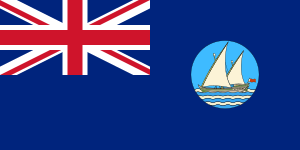
The British government signed "protection and friendship" treaties with nine tribes around Aden. These tribes would remain independent from British interference as long as they didn't make treaties with other foreign powers. Aden was declared a free zone in 1850. With people moving in from India, East Africa, and Southeast Asia, Aden grew into a "world city." By 1850, only 980 Arabs were listed as original inhabitants. The British presence in Aden caused problems with the Ottomans, who claimed to rule all of Arabia.
Ottoman Return
The Ottomans were worried about British expansion from India into the Red Sea and Arabia. They returned to the Tihama region in 1849 after being away for two centuries. There were many conflicts among the Zaidi imams, their deputies, religious scholars, and tribal leaders. Some people in Sana'a wanted law and order back and asked the Ottoman governor in Tihama to calm the country. Yemeni merchants thought the Ottomans' return would help their trade. An Ottoman force tried to capture Sana'a but was defeated.
The opening of the Suez Canal in 1869 made the Ottomans even more determined to stay in Yemen. In 1872, military forces from Constantinople moved beyond the lowlands to conquer Sana'a. By 1873, the Ottomans had conquered the northern highlands. Sana'a became the capital of the Ottoman province of Yemen.
The Ottomans learned from their past mistakes and tried to reduce the power of local lords in the highlands. They even tried to make Yemeni society more modern and less religious. The Ottomans tried to keep the tribes happy by forgiving rebellious chiefs and giving them government jobs. They also introduced reforms to improve the economy. However, corruption was common in the Ottoman government in Yemen. The Ottomans only controlled the highlands for a short time. The Zaydi tribes considered the Ottoman reforms against their religion. In 1876, the Hashid and Bakil tribes rebelled, and the Turks had to give them gifts to stop the uprising.
The tribal chiefs were hard to please, and constant violence hindered Ottoman efforts to bring peace. An Ottoman general suggested that the army should leave the highlands and stay in Tihama, to avoid endless fighting with the Zaydi tribes. The hit-and-run tactics of the northern tribes wore out the Ottoman military. The tribes disliked the Turkish reforms and resisted any attempts to create a central government. The northern tribes united under the House of Hamidaddin in 1890.
Imam Yahya Hamidaddin led a rebellion against the Turks in 1904, which made it hard for the Ottomans to govern. These revolts between 1904 and 1911 were very costly for the Ottomans, costing them many soldiers and a lot of money. The Ottomans signed a treaty with Imam Yahya Hamidaddin in 1911. Under this treaty, Imam Yahya was recognized as the independent leader of the Zaydi northern highlands. The Ottomans continued to rule the Shafi'i areas in the mid-south until they left in 1918.
Idrisid Emirate and Mutawakkilite Kingdom of Yemen
Imam Yahya Hamid ed-Din al-Mutawakkil had been ruling the northern highlands independently since 1911. After the Ottomans left in 1918, he wanted to reclaim the lands of his ancestors. He dreamed of a "Greater Yemen" stretching from Asir to Dhofar. These plans led to conflicts with the rulers in those areas, including the Idrisids, Ibn Saud, and the British government in Aden. The Zaidi imam did not accept the Anglo-Ottoman border agreement of 1905, saying it was made by two foreign powers occupying Yemen. This border treaty divided Yemen into "north" and "south."
In 1915, the British signed a treaty with the Idrisids, promising them safety if they fought the Turks. In 1919, Imam Yahya moved south to take over the nine British protectorates. The British quickly responded by moving into Tihama and occupying Al Hudaydah, then handing it over to their Idrisi allies. Imam Yahya attacked the southern protectorates again in 1922. The British used airplanes to bomb Yahya's tribal forces, which the tribes couldn't fight against.
In 1925, Imam Yahya captured Al Hudaydah from the Idrisids. He continued to attack the Idrisids until Asir fell under his control, forcing the Idrisids to ask to rule the region in the Imam's name. Imam Yahya refused, saying the Idrisids were not from Yemen. He believed the Idrisids and British were intruders who should be driven out. In 1927, when Imam Yahya's forces were close to Aden, the British bombed Ta'izz and Ibb for five days, forcing the Imam to retreat.
The Italian Empire was the first to recognize Imam Yahya as the "King of Yemen" in 1926. Italy also wanted to control the Farasan Islands. Italy had colonies nearby and hoped for more trade with Yemen. The Kingdom of Yemen wanted to take over Aden, and Imam Yahya also hoped for a Greater Yemen, possibly with Italy's help. This worried the British, who saw it as Italy supporting Imam Yahya's claim over Aden and Asir.
The Idrisids turned to Ibn Saud for protection from Yahya. But in 1932, the Idrisids broke their agreement with Ibn Saud and asked Imam Yahya for help against Ibn Saud, who wanted to take their lands. Imam Yahya demanded the return of all Idrisi territory. That same year, some Saudi liberals fled to Yemen and planned to remove Ibn Saud from the former Kingdom of Hejaz. Ibn Saud asked Britain for help, and the British sent weapons and airplanes. The British were concerned that Italy might help Ibn Saud if he had financial problems. Ibn Saud stopped the rebellion in 1933, and the Idrisids fled to Sana'a.
Negotiations between Imam Yahya and Ibn Saud failed. After a military conflict, Ibn Saud announced a ceasefire in May 1934. Imam Yahya agreed to release Saudi hostages and hand over the Idrisids to Saudi Arabia. Imam Yahya gave up the three provinces of Najran, Asir, and Jazan for 20 years and signed another treaty with the British in 1934. The Imam recognized British rule over the Aden protectorate for 40 years. Yahya gave in to Saudi and British demands because he feared for Al Hudaydah.
Even though the Imamate lost Asir, it managed to control rebellious tribes in the north using Yemeni troops trained in Iraq. With the country's borders now clear and peace established, city-based nationalists started to become more active. Many of these nationalists were not Zaidi Muslims and were based in the coastal area, Ta'izz, and British-occupied Aden. Some had studied in Cairo and had connections with the Muslim Brotherhood. Muslim Brotherhood members in Yemen supported the opposition and a Zaidi prince, Abdullah bin Ahmad al-Wazir, who wanted to overthrow Imam Yahya. On February 17, 1948, the opposition revolted in Sana'a and killed Imam Yahya. Crown prince Ahmad gathered northern tribes and retook the capital, ending the revolt on March 12, 1948.
Imam Ahmad changed his father's policies and opened Yemen's economy and society to the outside world. The Imamate became the first Arab state to accept Soviet aid. From 1955, Yemen signed friendship treaties and, from 1957, received large amounts of Soviet weapons and military advisers. When the Imam was sick and went abroad, crown prince Muhammad al-Badr led a pro-Soviet group, and communist activities increased. When the Imam returned in 1959, he harshly repressed communists.
In April 1956, Yemen joined a defense agreement with Syria and Egypt. In February 1958, it joined a federation with the United Arab Republic. At the same time, violence between clans erupted in Yemen and Aden, killing hundreds between 1956 and 1960. The defense pact was meant to stop republican movements, which were active in British-occupied Aden. As long as Yemen was part of the UAR, republicans wouldn't get help from Egyptian President Nasser. Although the federation only lasted three years, crown prince al-Badr continued to present himself as an Arab patriot, often speaking against "reactionary Arab monarchs."
Two States: North and South Yemen

Some people who wanted Yemen to modernize were influenced by Arab nationalism. This became clear when Imam Ahmad bin Yahya died in 1962. His son succeeded him, but army officers tried to seize power, starting the North Yemen Civil War. The Hamidaddin royalists were supported by Saudi Arabia, Britain, and Jordan (with weapons, money, and small military forces). The republicans were supported by Egypt, which sent a large military force. Israel secretly supplied weapons to the royalists to keep the Egyptian military busy in Yemen.
After six years of civil war, the republicans won in February 1968 and formed the Yemen Arab Republic. The revolution in the north happened at the same time as the Aden Emergency, which sped up the end of British rule in the south. On November 30, 1967, the state of South Yemen was formed, including Aden and the former Protectorate of South Arabia. This socialist state was later officially called the People's Democratic Republic of Yemen, and it began a program of nationalizing industries.
Relations between the two Yemeni states changed between peaceful and hostile. The South was supported by communist countries. The North didn't have the same strong international connections. In 1972, the two states fought a war. The war ended with a ceasefire and talks led by the Arab League, where it was agreed that unification would happen eventually. In 1978, Ali Abdallah Saleh became president of the Yemen Arab Republic.
After the war, the North complained about the South getting help from foreign countries, including Saudi Arabia. In 1979, fighting broke out again between the North and the South. There were renewed efforts to unite the two states. In 1986, thousands died in the South during a civil war between supporters of former president Abdul Fattah Ismail and his successor, Ali Nasser Muhammad. Ali Nasser Muhammad fled the country.
Unification and Challenges
In 1990, the two governments fully agreed to unite Yemen. The countries merged on May 22, 1990, with Saleh as President. The President of South Yemen, Ali Salim al-Beidh, became Vice-President. A single parliament was formed, and a new constitution was agreed upon. In the 1993 election, the first after unification, Saleh's party won the most seats.
After the invasion of Kuwait in 1990, Yemen's President opposed military action by non-Arab countries. As a member of the United Nations Security Council, Yemen didn't vote for some resolutions about Iraq and Kuwait and voted against using force. This angered the U.S. Saudi Arabia expelled 800,000 Yemenis in 1990 and 1991 to punish Yemen for its stance.
After food riots in 1992, a new government was formed in 1993, including parties from both former Yemeni states. However, Vice-President al-Beidh moved to Aden in August 1993 and said he wouldn't return until his complaints were addressed. These included violence against his party and the economic neglect of the south. Talks to end the political problems continued into 1994. The government became ineffective due to political fighting.
An agreement between northern and southern leaders was signed in Amman, Jordan, on February 20, 1994, but it couldn't stop the civil war. During these tensions, the northern and southern armies (which had never fully combined) gathered at their borders. The May-July 1994 civil war in Yemen resulted in the defeat of the southern forces, and many southern leaders went into exile. Saudi Arabia actively helped the south during this war.
Saleh became Yemen's first directly elected president in 1999, winning 96.2% of the vote. In June 2000, the Treaty of Jeddah was signed, setting the border with Saudi Arabia.
After the September 11 attacks in the United States, President Saleh promised U.S. President George W. Bush that Yemen would help in the "War on Terror." In 2001, there was violence around a vote that seemed to support extending Saleh's rule and powers.
The Shia insurgency in Yemen began in June 2004 when a religious leader, Hussein Badreddin al-Houthi, started an uprising against the government. The government said the Houthis wanted to overthrow it and create a strict religious state. The rebels said they were "defending their community against discrimination."
In 2005, at least 36 people died in clashes between police and protesters over rising fuel prices. In the 2006 presidential election, Saleh won with 77.2% of the vote. There were a series of bomb attacks on police, government buildings, and tourist sites in 2008. Car bombings outside the U.S. embassy in Sana'a killed 18 people in September 2008.
Al Qaeda in Yemen
In January 2009, the Saudi and Yemeni branches of al-Qaeda joined to form Al-Qaeda in the Arabian Peninsula (AQAP). AQAP is based in Yemen, and many of its members were Saudis who had been released from Guantanamo Bay. Saleh released many al-Qaeda suspects, but terrorist activities continued.
The Yemeni army launched a new attack against the Shia rebels in 2009, helped by Saudi forces. Tens of thousands of people were forced to leave their homes. A new ceasefire was agreed in February 2010. However, by the end of the year, Yemen claimed that 3,000 soldiers had been killed in renewed fighting. The Shia rebels accused Saudi Arabia of helping groups to suppress their beliefs in Yemen. Saleh's government used Al-Qaeda in its wars against the Houthi clan.
Some news reports suggested that, on orders from U.S. President Barack Obama, U.S. warplanes fired missiles at what officials claimed were Al Qaeda training camps in December 2009. Instead, they hit a village, killing 55 civilians. Another airstrike happened in December. The U.S. launched drone attacks in Yemen to stop a growing terror threat due to political chaos. These drone strikes have been criticized by human rights groups for killing innocent civilians.
Government Instability (2011-Present)
The Yemeni Crisis began with the 2011-2012 revolution against President Ali Abdullah Saleh, who had led Yemen for over two decades. After Saleh left office in early 2012, his former vice president, Abd Rabbuh Mansur Hadi, became president. Hadi struggled to unite the country and fight threats from both Al Qaeda in the Arabian Peninsula and Houthi militants. In 2014, Houthi fighters took over Sana'a and forced Hadi to negotiate a "unity government." The rebels continued to pressure the government until Hadi resigned in January 2015 after his palace was attacked.
The next month, the Houthis declared they were in control of the government, dissolving Parliament and setting up a temporary committee. However, Hadi escaped to Aden, declared himself the rightful president, and called on loyal officials to join him.
The 2011 Revolution
The 2011 Yemeni revolution was part of the larger Arab Spring protests. It started because of unemployment, poor economic conditions, and corruption, as well as government plans to change the constitution so Saleh's son could become president.
In March 2011, police snipers shot at pro-democracy protesters in Sana'a, killing over 50 people. By May, dozens were killed in clashes between troops and tribal fighters. Saleh began to lose international support. In October 2011, Yemeni human rights activist Tawakul Karman won the Nobel Peace Prize. The UN Security Council condemned the violence and called for a transfer of power. On November 23, 2011, Saleh flew to Saudi Arabia to sign a plan for political change, which he had previously refused. He agreed to transfer power to his deputy, Vice President Abd Rabbuh Mansur Hadi.
Hadi became president for a two-year term after winning an election in February 2012, where he was the only candidate. A unity government was formed. Hadi was supposed to oversee the writing of a new constitution, followed by elections in 2014.
Events in 2012
Saleh returned in February 2012. Despite protests, parliament gave him full protection from being charged with crimes. Saleh's son still had strong influence over parts of the military. In September 2012, a car bomb in Sana'a killed 11 people.
By 2012, a small group of U.S. special forces was in Yemen to help fight increasing terror attacks by AQAP. Following the election of President Abd Rabbuh Mansur Hadi, the Yemeni military pushed back against a group called Ansar al-Sharia and recaptured the Shabwah Governorate.
Houthi Takeover and Civil War

In 2014, the Houthi movement, which had been fighting the Yemeni government since 2004, began to gradually take over Yemen. They defeated government forces in battles like the Battle of Amran and the Battle of Sana'a (2014). Their advance continued, leading to the start of the Saudi Arabian-led intervention in Yemen. The Houthis attacked Aden on March 25, 2015, starting the Battle of Aden (2015). Despite Saudi airstrikes, the Houthis advanced into parts of Aden.
The situation changed on July 14, when anti-Houthi forces pushed them back. By August 6, 2015, Hadi's government had captured much of Taiz, and Houthis were expelled from the Lahij area. However, on August 16, Houthi forces counterattacked and forced Hadi's forces to retreat. In Hadramaut, Al-Qaeda in the Arabian Peninsula (AQAP) took over Mukalla in the Battle of Mukalla (2015), and later took over Zinjibar and Jaar in December 2015.
In 2016, Hadi's government defeated Houthi forces in the Battle of Port Midi and retook Mukalla from AQAP in the Battle of Mukalla (2016). In January 2017, the United States carried out a raid to get information about AQAP. In December, Hadi's government began an attack on Al Hudaydah. In June 2018, they attacked the city of Hudaydah itself, starting the Battle of Al Hudaydah, which is considered the largest battle in the war.
In December 2017, former president Ali Abdullah Saleh was killed. He had been an ally of the Houthis since 2014 but recently changed sides. The war in Yemen has also caused severe problems like cholera outbreaks and widespread hunger.
After losing support from the Saudi-led group, Yemen's President Abd Rabbuh Mansur Hadi resigned. A new Presidential Leadership Council took power in April 2022.
See also
 In Spanish: Historia de Yemen para niños
In Spanish: Historia de Yemen para niños
- History of Asia
- History of the Middle East
- List of rulers of Saba and Himyar
- Imams of Yemen
- List of presidents of Yemen
- Politics of Yemen
- South Arabia
- South Yemen
- Timeline of Yemeni history






